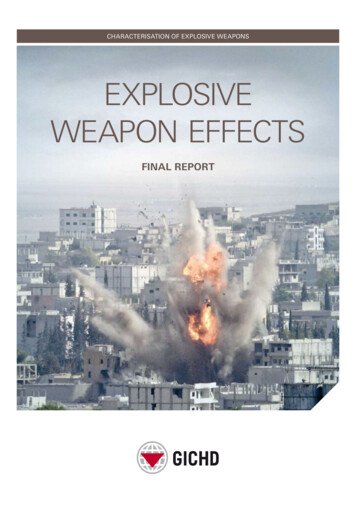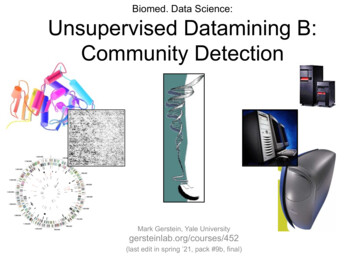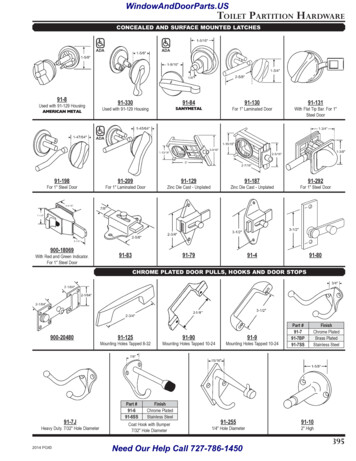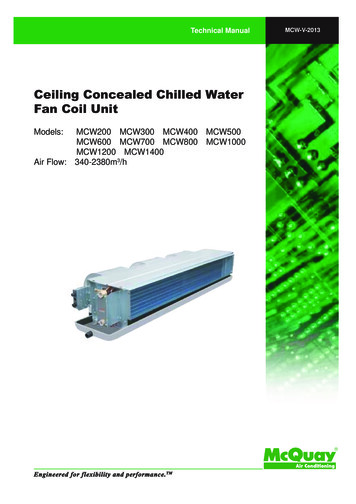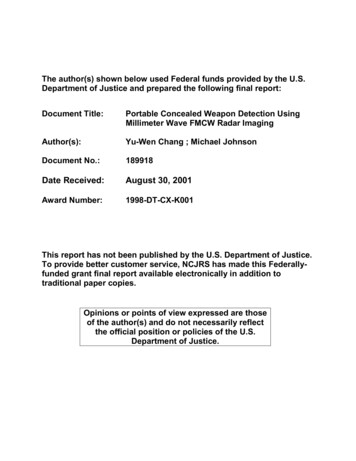
Transcription
The author(s) shown below used Federal funds provided by the U.S.Department of Justice and prepared the following final report:Document Title:Portable Concealed Weapon Detection UsingMillimeter Wave FMCW Radar ImagingAuthor(s):Yu-Wen Chang ; Michael JohnsonDocument No.:189918Date Received:August 30, 2001Award Number:1998-DT-CX-K001This report has not been published by the U.S. Department of Justice.To provide better customer service, NCJRS has made this Federallyfunded grant final report available electronically in addition totraditional paper copies.Opinions or points of view expressed are thoseof the author(s) and do not necessarily reflectthe official position or policies of the U.S.Department of Justice.
Portable Concealed Weapon Detection UsingMillimeter Wave FMCW Radar ImagingFINAL REPORTPERlOD OF PERFORMANCE:(February 10,1998 through August 31,2000)NATIONAL INSTITUTE OF JUSTICEOFFICE OF SCIENCE AND TECHNOLOGYGk4NT NO, 98-DT-CX-KO01Date: 1 August 2001PROPERTY OFNotional Criminal Justice Reference Service (NCJRS)Box 6000Rockviile, MD 20849-6000Principal Investigator:Dr. Yu-Wen ChangPrincipal Engineer: Michael Johnson-CHANG Industry h c .1925 McKinley Ave. Suite F, La Verne, CA 91750Tel: (909) 596-7888Fax: (909) 596-8388This document is a research report submitted to the U.S. Department of Justice. This reporthas not been published by the Department. Opinions or points of view expressed are thoseof the author(s) and do not necessarily reflect the official position or policies of theU.S. Department of Justice.Cd I
Portable Concealed Weapon Detection Using Millimeter Wave Fh4CW Radar ImagingTABLE OF CONTENTSPAGE NUMBERSECTION NUMBER0-1.O ABSTRACTi2.0 INTRODUCTION23.0 SYSTEM DESCRIPTION3.1 94 GHz Radar System3.2 Gimbaled Fast Scan Antenna System3.3 Data Acquisition3.4 Hand Held Operation4568114.0 DATA ANALYSIS4.1 FMCW Radar Waveform Processing4.2 3D Feature Extraction4.3 Image Processing4.4 Selected Data125.0 SAFETY IMPACT CALCULATION236.0 CONCLUSIONS AND RECOMMANDATIONS247.0 ACKNOWLEDGEMENT268.0 REFERENCE27CHANGIndust yInc.98-DT-CX-KO0 1This document is a research report submitted to the U.S. Department of Justice. This reporthas not been published by the Department. Opinions or points of view expressed are thoseof the author(s) and do not necessarily reflect the official position or policies of theU.S. Department of Justice.1314161811
Portable Concealed Weapon Detection Using Millimeter Wave FMCW Radar Imaging1.0 ABSTRACTUnobtrusive detection of concealed weapons on persons or in abandoned bags would provide lawenforcement a powerful tool to focus resources and increase traffic throughput in high-risksituations. Under a National Institute of Justice, Office of Science and Technology Grant, Number98-DT-CX-KOO1, we have developed a fast image scanning 94GHz radar system that is suitable forportable operation and remote viewing of radar data. This system includes a novel fast imagescanning antenna that allows for the acquisition of medium resolution three dimensional millimeterwave images of stationary targets with frame times on order of one second. The three-dimensionalradar data allows for potential isolation of concealed weapons from body and environmental cluttersuch as nearby furniture or other people. The radar is an active system different from the millimeterwave passive imaging system that depends on millimeter wave emissiodreflection contrast betweenthe weapon and the bodyklothing. Therefore, the radar returned image data is the same indoor andoutdoor. The 94 GHz radar emitted power of approximately 1mW is low and poses no healthconcerns for operator or targets. The low power operation is still sufficient to penetrate heavyclothing or material. Small system size allows for easy transport and rapid deployment of the systemas well as an easy migration path to future hand held systems with a special image scan techniqueinvented by us. A much faster scanning antenna and data acquisition system is deemed feasible forhandheld concealed weapon detection as a result of this research.Keywords: concealed weapon detection, abandoned bag search, millimeter-wave, short-range radar,fast image scan radar, portable radar, full body scanCHANGIndustry Inc.98-DT-CX-KO0 1This document is a research report submitted to the U.S. Department of Justice. This reporthas not been published by the Department. Opinions or points of view expressed are thoseof the author(s) and do not necessarily reflect the official position or policies of theU.S. Department of Justice.1
Portable Concealed Weapon Detection Using Millimeter Wave FMCW Radar Imaging2.0 INTRODUCTIONThe ability to detect a concealed weapon under clothing at a standoff distance of 10 feet and longercan greatly enhance potential threat detection in situations such as crowd control, school safety,airport security and et. al. The detection can be outdoor and/or indoor. The detector can behandheld for portable short-range detection, or fixedhehicle-mounted for scanning a crowd.Because of the clothing, visible detection of a concealed weapon is impossible. Detection with aninfrared thermal detector is also not practical because of the very small temperature contrast of aconcealed weapon under clothing and especially heavy clothing. Several techniques are currentlybeing investigated under National Institute of Justice contracts: Ultrasound echo detection ofconcealed weapon through clothing, microwave signal reflection through clothing and body to detectconcealed weapon, passive millimeter wave imaging to detect temperature contrast of the concealedweapon with the body through clothing, and the millimeter wave radar (active) imaging throughclothing. There was also a concept of using a magnetometer array for ferric metal weapon detection.Each of the above techniques has its advantages and drawbacks. This research project underNational Institute of Justice, Office of Science and Technology sponsorship was to investigate anactive millimeter wave imaging techniques and technologies that could enable the design ofhandheld detectors with a fast image scan time frame to detect concealed weapon at a minimumrange of 10 feet. Our research results also indicated further work to be conducted in conjunctionwith the motion of the person, and the potential limitations of the technique.Active millimeter-wave imaging of subjects for the purpose of non-invasive search has manyattractive aspects: it is possible to produce a reasonable small beam with an antenna compatible withportable or handheld use, system performance is not affected by weather or indoor operation, andfast frame times with good signal to noise ratios can be obtained with low power non-destructiveradiation. Though such a system has many attractive aspects, millimeter-wave radar images show amarked difference fiom their visible cousins. The signal and image processing challenges arisingfiom specular reflection, glint, phase cancellation, and environmental clutter require a good way togather data in a variety of environments.CHANG Industry Inc. has developed a portable fast scanning millimeter-wave radar imagingsystem that will be able to gather data on a variety of subjects in a variety of roles. The system issuitable for tripod mounting and data can be visualized remotely on a laptop or desktop computersystem. This form factor allows the system to be deployed as an entry portal scanner, as anabandoned bag scanner, or as a patrol car mounted system. This flexibility will allow the collectionof a large amount of data fiom a variety of missions leading to solution of the signal processingproblems that will allow a handheld, or a small commercially available system to be produced.The selection of the 94GHz band was driven by the compatibility of the required antenna sizewith handheld or small portable operation. Using only a ten-inch antenna it is possible to generate abeam spot size of less than two inches at a ten-foot standoff distance. A spot size of less than oneinch is achievable at five feet, which is compatible with abandoned bag search. This spot size yieldsan image of metallic and possibly non-metallic targets with a reasonable resolution that can be oversampled for image processing and target identification purposes. By using an active system theimage quality is not dependent on “temperature contrast” or the presence of cold sky radiation andalleviates the need for an extremely high sensitivity receiver. Using less than 1 mW of radiatedpower there is sufficient signal to noise ratio that a fast frame time is possible by scanning a singleCHANGIndustry Inc.98-DT-CX-KO01This document is a research report submitted to the U.S. Department of Justice. This reporthas not been published by the Department. Opinions or points of view expressed are thoseof the author(s) and do not necessarily reflect the official position or policies of theU.S. Department of Justice.2
Portable Concealed Weapon Detection Using Millimeter Wave FMCW Radar Imaging0beam thereby removing the need for an expensive sensor array. This small power output is wellbelow FCC health guidelines for radiated exposure’ yet still easily penetrates many layers of heavyclothing.Figure 2.1 shows the detection of a small Saturday Night Special handgun concealed in a leatherboot and detected by a 94GHz imaging radar initially developed with a circular scan technique, Theradar. image with and without the handgun clearly indicates that the concealed handgun can bedetected even through heavy leather.baFigure 2.1 Close Range radar image of leather boot (a) empty (b) containing handgunThe choice of an active system suffers from glint problems and a loss of signal or imagedistortion from constructive and destructive interference from multiple strong reflectors in theimage. Isolating returns from target weapons and bony portions of the human body is also achallenge. These problems can be mitigated by the fine range resolution that is provided by an activesystem to allow targets to be localized in space away from clutter. As a result of a platform that canproduce good data signal processing solutions should be able to be developed to solve the challengesof clutter and target identification.aCHANG Industry Inc.98-DT-CX-KO01This document is a research report submitted to the U.S. Department of Justice. This reporthas not been published by the Department. Opinions or points of view expressed are thoseof the author(s) and do not necessarily reflect the official position or policies of theU.S. Department of Justice.3
Portable Concealed Weapon Detection Using Millimeter Wave FMCW Radar Imaging3.0 SYSTEM DESCRIPTIONThe system we developed is made up of four major parts:1) A potentially low cost gimbal-mounted 94 GHz antenna with a specially designed aperturecapable of fast scanning a pencil beam with a beamwidth of about 1.7".2) A 94GHz radar with frequency modulated continuous wave (FMCW) waveform generatedby an upconversion technique driven by a custom-made ultralinear swept frequencygenerator.3) A custom-made 2-4 GHz microwave ultralinear sweep frequency generator for upconvertingto the 94 GHz frequency region with a range resolution in the order of 3 inches with the 2GHz wide sweep. Potential range resolution as small as 1.5 inches is deemed feasible with a4 GHz wide sweep.4) A custom data acquisition system to capture the two-dimensional image generated by theimage scanning radar. The data acquisition system was built into an embedded PC runningLinux. Data can be passed from the embedded computer to a laptop, workstation, or anyEthernet capable system. Data is processed and visualized on the remote system so the powerof the latest computers can be used to experiment with signal processing solutions.The system can be deployed at an entry portal and images can be evaluated at a co-locatedworkstation or the system could be plugged into a building network and concealed weapon datacould be viewed and analyzed at a central monitoring center. For abandoned bag search applicationsthe system can be placed on or by a robot and analyzed at a safe location by connecting the computerto a laptop via standard long Ethernet cable or even hrther by utilizing wireless LAN technology.CHANG Industry Inc.98-DT-CX-KO01This document is a research report submitted to the U.S. Department of Justice. This reporthas not been published by the Department. Opinions or points of view expressed are thoseof the author(s) and do not necessarily reflect the official position or policies of theU.S. Department of Justice.4
Portable Concealed Weapon Detection Using Millimeter Wave FMCW Radar Imaging3.1 94GHz Radar System.2-4Gl-l vcoLinearAcquisitionsystem191GHzGunn OscillatorIflFigure 3.1 FMCW Radar Block DiagramThe heart of our scanning system is the wide band 94GHz FMCW radar shown in Figure 3.1 Aportion of the output from a 91GHz Gunn oscillator is mixed with a 2 to 4GHz ramp generated froma voltage controlled oscillator (VCO) upconverted and transmitted through a circulator and out theantenna feed as 93-95GHz output. Lower band energy is filtered in the upconverter and band limitedby the circulator preventing 87-89GHz energy from being radiated. Energy returns from the targetpropagate through the circulator and are mixed with another portion of the 91GHz Gunn Oscillatoroutput downconverted and filtered then mixed with the 2 to 4GHz generating ramp. The output fromthis final mixing stage is then filtered and amplified for data acquisition. The bandwidth of themillimeter wave components are such that they have a 6GHz bandwidth that can support sweepsfrom 93-99GHz. This bandwidth will allow the system to be swept much wider once suitablemicrowave components are developed.Sweep Bandwidth (SBW)Sweep Period (7,)Sample RateNumber of Samples2GHz1I12.6pS20.48Msps256Table 3.1 Typical sweep parameterseThe signal return is a superposition of frequencies related to the range of target returns within thebeam. For example, using typical sweep parameters from Table 3.1, we see that the sweep rate isSB&, or 159THdsecond. Signal reflected from an object 1 meter away has a time of flight ofroughly 7ns. Since the received signal is a linear swept frequency wave delayed from thetransmitted linear swept frequency waveform by the 7ns round trip delay time, the difference in theradar intermediate frequency output is a 1.1MHz signal corresponding to the target distance from theCHANG Industry Inc.98-DT-CX-KO01This document is a research report submitted to the U.S. Department of Justice. This reporthas not been published by the Department. Opinions or points of view expressed are thoseof the author(s) and do not necessarily reflect the official position or policies of theU.S. Department of Justice.5
Portable Concealed Weapon Detection Using Millimeter Wave FMCW Radar Imagingradar. The current system yields a range resolution of roughly 3 inches. We would like toinvestigate a wider sweep of 4 GHz or wider to produce 1.5 inch or even 1 inch range resolution.This fast sweep rate places the signals of interest in the 1-5MHz range which is more easily filteredfrom the near carrier l/f noise and is still low enough to be easily acquired by modem analog todigital converters.To generate target return signals with very sharp frequency characteristics and hence accuraterange information, it is necessary to have a very linear frequency sweep to drive the system.Frequency generating technologies that produce very linear frequency responses are available suchas YIG oscillators and phase locked systems. However, none of these can generate a sweep at thespeeds necessary for an imaging-radar of this type. A standard VCO (Voltage Controlled Oscillator)was used and the ramp used to modulate the VCO is modified to produce a linear frequencyresponse at the output. This waveform is generated initially by checking the frequency response ofthe VCO with laboratory test equipments and then optimizing the driving waveform by sharpeningthe signal return from a known target with the adjustment of the voltage driving waveform while theVCO is in the system. This technique is quite successful and consistently has produced good results.In a fielded system a way to recalibrate the system in the field may still be required. Some work todevelop techniques analyze recalibration requirements to allow in system field calibration wereperformed.3.2 Gimbaled Fast Scan Antenna System.The radar is mounted on a two-axis gimbal system that allows the system to be coarsely aimed at atarget or subject. Currently the operator accomplishes course aiming manually. In the fbture acollocated video camera and some simple image processing could automatically aim the system. Thesystem utilizes a fast horizontal line scan generated by our fast scanning antenna and a slow verticalscan generated by the gimbal to scan images. Figure 3.2 is a photo of the development systemconsisting of the FMCW radar, acquisition system and embedded control solution mounted on atwo-axis gimbal.CHANGIndustryInc.98-DT-CX-KO01This document is a research report submitted to the U.S. Department of Justice. This reporthas not been published by the Department. Opinions or points of view expressed are thoseof the author(s) and do not necessarily reflect the official position or policies of theU.S. Department of Justice.6
Portable Concealed Weapon Detection Using Millimeter Wave FMCW Radar ImagingFigure 3.2 Measured beam pattern of the scanning antenna at different scan angles.0The antenna is an offset parabolic with a novel feed point that allows the beam to be mechanicallyscanned k4.5". This antenna has a beam width of roughly 1.7" and has a peak gain of 42dB, and hasan antenna efficiency very close to 50%. Figure 3.3 shows a beam pattern measurement of thecurrent antenna at 8 different scan positions. Though this antenna only gives us a total scan width of1.6 feet at 10 feet target distance we feel a wider scan width of roughly 3 feet is possible once a newantenna is designed. At 10 feet, each beam spot width is 3.56 inches. By over-sampling the beamand generating 54 sweeps per line we are able to acquire a scan line in 9 ms when running with theparameters shown in Table 3.1. This yields a 54x108 128point three-dimensional data set in justunder one second. The system is capable of roughly twice this speed on the acquisition side but islimited mechanically by the inertia of the system for now.CHANG Industry Inc.98-DT-CX-KO01This document is a research report submitted to the U.S. Department of Justice. This reporthas not been published by the Department. Opinions or points of view expressed are thoseof the author(s) and do not necessarily reflect the official position or policies of theU.S. Department of Justice.7
Portable Concealed Weapon Detection Using Millimeter Wave FMCW Radar ImagingFigure 3.3 Measured beam pattern of the scanning antenna at different scan angles.3.3 Data Acquisition.SweepGeneration-SweepMemoryt5pc lo4 BusFPGA\AID--PC 104ComputerrMemoryNetworkFigure 3.4 Data acquisition Block DiagramFigure 3.4 shows an overview of the data acquisition and control system. At the start of the systemdevelopment no acquisition system suitable for embedded work was available that could meet ourdata acquisition needs. A data acquisition system and an ultra-linear sweep frequency generationelectronics were developed in house in a PC-104 form factor. Control logic was implemented onCHANG Industry Inc.98-DT-CX-KO01This document is a research report submitted to the U.S. Department of Justice. This reporthas not been published by the Department. Opinions or points of view expressed are thoseof the author(s) and do not necessarily reflect the official position or policies of theU.S. Department of Justice.8
Portable Concealed Weapon Detection Using Millimeter Wave FMCW Radar Imaging0field programmable gate array (FPGA) to allow for maximum system flexibility. The systemconsists of a 40Msps 12bit ADC that writes into inexpensive SDRAM memory under thesupervision of control logic on the FPGA. Data acquisition is closely coupled to sweep generation onthe 14 bit 80 MHz DAC. Running both systems on the same clock produces consistent signals withlow jitter. Logic to synchronize pixel timing to sweep generation is also conveniently located on theFPGA where it could be updated as the system evolved. By using SDRAM additional overhead logicwas required but the overall memory capacity of the system was able to be very large, 16M samples.This capacity allows us to store a 64x512 256voxel data set without paging the data to disk orsystem memory.Figure 3.5 DAC Linear Sweep Generator (left) and ADC acquisition system (right)0By using the PC-104 form factor, we are able to place a fully functional Linux based system onthe unit itself. The assembled embedded control and acquisition system is shown in Figure 3.6. Thisallows us to put a large amount of system software on the unit and gives us a platform that can beautomated in a wide variety of ways. The system can be accessed over the network simplifying thesending of control commands as well as data retrieval. Software debugging tasks are also simplifieddue to the large volume of good tools available. Since the data acquisition runs without anyinterference from the host bus, latency from the operating system overhead is not an issue. Slowthroughput from the PC-I04 bus prevents the use of the system for full motion scans but is morethan adequate for still frame applications. Though signal processing can be performed on theembedded computer, data is analyzed on the client to allow the full resources of a workstation todevelop and test complicated signal processing solutions.CHANG Industrylnc.98-DT-CX-KO01This document is a research report submitted to the U.S. Department of Justice. This reporthas not been published by the Department. Opinions or points of view expressed are thoseof the author(s) and do not necessarily reflect the official position or policies of theU.S. Department of Justice.9
Portable Concealed Weapon Detection Using Millimeter Wave FMCW Radar ImagingFigure 3.6 Data Acquisition System (Installed)The current performance of the data acquisition system and radar should allow the system toacquire data at a much faster rate (approximately 10 frames per second for 64x256 128point data).Due to the physical limitations of attempting to move a system with a large inertia at this speed thecurrent mechanical system is limited to no more than twice its current one second scan time.Improved mechanical design and a reduction in the weight of the radar components, antenna and linescanning subsystem would allow the system to be run at a higher fiame rate. The current one secondscan time is however adequate for full body scan in controlled portal passing situations.CHANG Industry Inc.98-DT-CX-KO01This document is a research report submitted to the U.S. Department of Justice. This reporthas not been published by the Department. Opinions or points of view expressed are thoseof the author(s) and do not necessarily reflect the official position or policies of theU.S. Department of Justice.10
Portable Concealed Weapon Detection Using Millimeter Wave FMCW Radar Imaging03.4 Hand Held Operation.The operation of Hand held operation is anticipated with a fast mechanical scan in conjunctionwith a hand-scan inertial positioning system. In a previous grant with NU (Grant No. 97-IJ-CXKO15), the feasibility of implementing a handheld inertial positioning system was examined.Figure 3.6 shows a mockup of a handheld concealed weapon scanner incorporating with the fastimage scan at 94 GHz. The handgrip of this design would house a commercial rechargeable battery.We determined that with the latest accelerometer technology, it is definitely feasible to achieve agood quality image scan with the handheld inertial positioning system providing sufficient scanlineregistration.Figure 3.6 Mockup of a 94 GHz handheld concealed weapon detectorAlthough the present 94 GHz radar frontend were fabricated in-house with the use of solid statedevices and hybrid circuits, miniaturization of the 94 GHz transceiver frontend is anticipated in thefbture though the use of Millimeter-wave Monolithic Integrated Circuit (MMIC) chip devices thatare now available commercially. The low transmitted power (under 1 mW) of the system makesminiaturization of the electronics very feasible using three-terminal solid-state devices. The threeterminal devices used in MMIC’s will also provide stable frequency operation under differentambient temperature conditions. A MMIC chip solution is potentially very low cost making a handheld concealed weapon detector using this technology affordable for the law enforcementcommunity. We envision that our design would allow for operation of the 94 GHz concealed weapondetector for a period up to eight hours.CHANG Industry Inc.98-DT-CX-KO01This document is a research report submitted to the U.S. Department of Justice. This reporthas not been published by the Department. Opinions or points of view expressed are thoseof the author(s) and do not necessarily reflect the official position or policies of theU.S. Department of Justice.11
Portable Concealed Weapon Detection Using Millimeter Wave FMCW Radar Imaging4.0 DATA ANALYSISThe signal processing challenges consist of three major parts. The first challenge is to process theraw FMCW radar returns, remove noise, system artifacts, and pre-scale data. The second challengeis much larger and consists of processing the data volumes to remove effects of systemphenomenology that can obscure the meaning of the data. The third challenge is formatting andpresenting the data in such a way that an operator or computer algorithm can better understand andinterpret the data.Based on interviews with a variety of local law enforcement professionals including Captain SidHeal of the Los Angeles Sheriffs Department we determined that the ultimate goal of a CWD systemfor law enforcement use would be full processing of the scan data and the output of a SAFE orNOTSAFE indicator. This requirement would allow officers to not divert their attention formsituational awareness and safety but also allow for an impartiality that can prevent criticism of theofficer’s actions in the case of false alarms. Figure 4.1 shows seven weapons taken from suspects inthe Los Angeles area and given on loan for study. These weapons represent the more commonweapons found on criminals with the exception of the “plastic” Glock pistol that was included tojudge system performance against a mostly non metallic weapon.Figure 4.1 A variety of potential concealed weapons of interest to this program.aThough pattern recognition and advanced signal processing was outside of the scope of thecurrent effort, preprocessing of the data to try to emphasize consistent weapon and body features wasCHANG Industry Inc.98-DT-CX-KO01This document is a research report submitted to the U.S. Department of Justice. This reporthas not been published by the Department. Opinions or points of view expressed are thoseof the author(s) and do not necessarily reflect the official position or policies of theU.S. Department of Justice.12
Portable Concealed Weapon Detection Using Millimeter Wave FMCW Radar Imaging0undertaken. In addition since a potential intermediate application of the system would be thescanning of stationary targets, such as abandoned bags, by trained operators some effort to producerecognizable images was performed. Processing of the radar data acquired from the system requiresthree stages before reduced data sets that could be used for pattern recognition research are required:FMCW Waveform processing, 3D feature extraction and image processing.4.1 FMCW Waveform Radar ProcessingBefore any image generation can be performed, the return from each radar sweep must be processedto yield the range and signal return strength of the target, typically represented by the multiplereflector characteristics of the target in the beam. Since the return signals from the radar havespectral content based on the range of reflectors in the beam, initially an FFT with proper windowingis performed on the time domain signal. The spectrum is then filtered to remove spurious signals thatare generated by the system. Since the signal strength falls off by range, the resultant spectrum isthen scaled by lh4, where r is the target range, to equalize the returned signal strength. Figure 4.1depicts a typical isolated handgun return in the time and frequency domain.Figure 4.1 Typical return from a handgun in the time (top) and frequency domain (bottom)aThe range resolution of the radar system is a function of the bandwidth and linearity of the sweep.Non-linearity in the sweep will broaden the return frequency peak from a target feature. Though thispeak broadening or frequency spreading will no reduce the range accuracy of the system, except insevere cases, it will hover reduce the resolving power of the system. Broadened peaks can beprocessed and have their central peak extracted which is useful in classic radar applications whereCHANGIndustry Inc.98-DT-CX-KO01This document is a research report submitted to the U.S. Department of Justice. This reporthas not been published by the Department. Opinions or points of view expressed are thoseof the author(s) and do not necessarily reflect the official position or policies of theU.S. Department of Justice.13
Portable Concealed Weapon Detection Using Millimeter Wave FMCW Radar Imaging0target range is of primary interest. In an imaging radar application for purposes of CWD broadenedpeaks are problematic however as they do no allow closely spaced features to be resolved. CWDapplications are characterized by an abundance of clutter reflectors that have radar cross-sections onthe same order of magnitude as the target signals.Due to this need for good range
Aug 30, 2001 · portable operation and remote viewing of radar data. This system includes a novel fast image- scanning antenna that allows for the acquisition of medium resolution three dimensional millimeter wave images of stationary targets with



